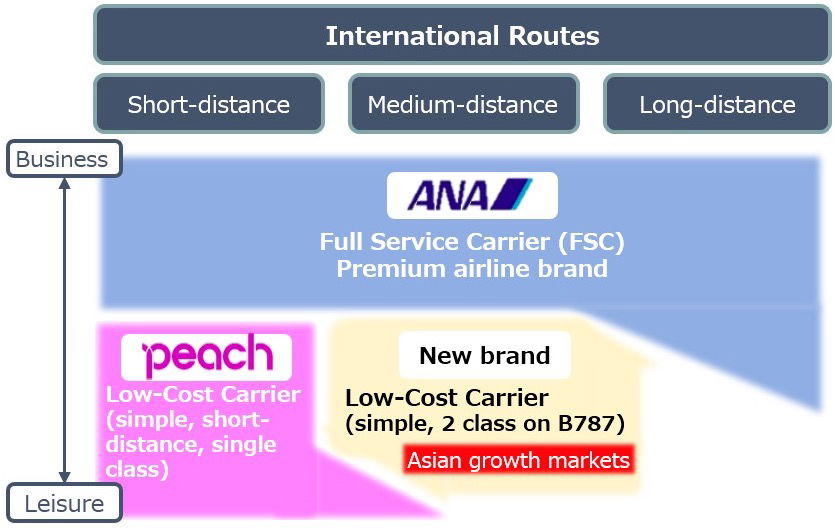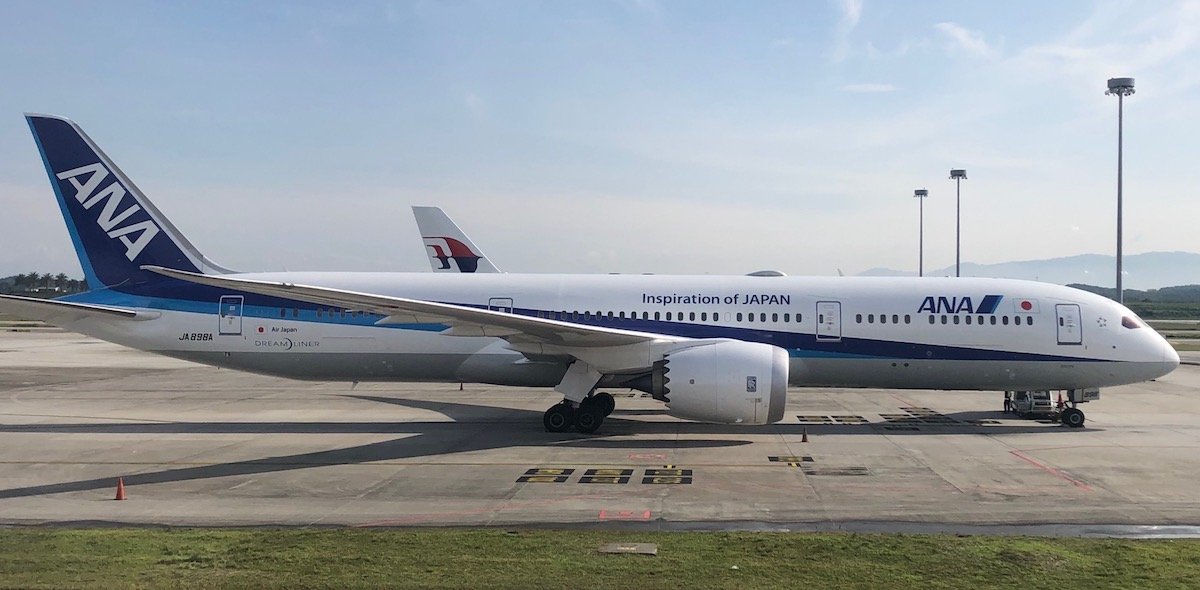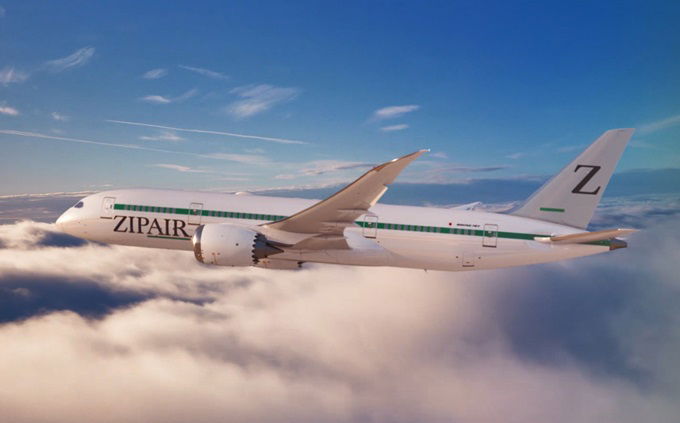All Nippon Airways has announced a business restructuring. In addition to retiring 22 Boeing 777s, the airline will also be forming a new low cost carrier.
In this post:
ANA’s new low cost carrier details
Currently the airline group has two airlines:
- There’s All Nippon Airways, which is the full service airline operating both long haul and short haul flights
- There’s Peach, which is the low cost carrier operating short haul flights with one class Airbus A320-family aircraft
 Peach is ANA’s short haul low cost carrier
Peach is ANA’s short haul low cost carrier
Now All Nippon Airways will be introducing a third airline brand, which will also be a low cost carrier. The airline will:
- Target demand for low-cost, medium-distance flights to destinations in Southeast Asia and Oceania
- Be established in the 2022 fiscal year (which starts on April 1, 2022)
- Use two class Boeing 787 aircraft with 300+ seats
- Use Air Japan’s foundation in order to begin operations quickly; Air Japan is a subsidiary that operates flights on behalf of All Nippon Airways, though when you’re on an Air Japan flight you probably don’t even realize it
Here’s a diagram ANA shows to illustrate the new airline structure:

As of now that’s just about all the information we have. It’s remains to be seen:
- What routes the airline will operate
- What we should expect from the onboard product
- If the airline is taking over 787s from ANA, or acquiring them in other ways
 Will the airline acquire 787s from ANA?
Will the airline acquire 787s from ANA?
Why is ANA launching a new low cost carrier at this point? As the airline describes it:
- Demand for business travel will decrease and likely “not fully return to previous levels due to changes to the nature of work, such as the widespread popularity of online conferences and meetings”
- Demand for leisure travel will likely continue to remain robust
- The airline sees potential for demand in untapped markets, with preference for “greater hygiene during travel, airlines with ESG policies, adoption of contactless and automated options, simplistic services, and more customization options”
This sounds a whole lot like ZIPAIR Tokyo
If the concept of a Japanese airline starting a low cost subsidiary with 787s that are in a two class configuration sounds familiar, well… that’s for good reason.
ZIPAIR Tokyo has just launched operations. This is Japan Airlines’ low cost airline that operates 787s that were acquired from JAL. The airline has just launched service between Tokyo Narita and Seoul Incheon, and plans to soon expand to Bangkok, Honolulu, and beyond.
ZIPAIR Tokyo’s 787s don’t feature personal televisions onboard, but rather have streaming entertainment. In economy seats are in a 3-3-3 configuration, while in business class there are reverse herringbone seats. ZIPAIR Tokyo also has the world’s most basic business class.
So yeah, ANA’s concept here isn’t exactly novel, as it sounds awfully similar to JAL’s low cost carrier concept.
 ZIPAIR Tokyo 787
ZIPAIR Tokyo 787
Varied success with low cost airlines
Over the years we’ve seen a countless number of full service airlines around the world launch low cost subsidiaries, though with mixed success. From Delta’s Song, to Air France’s Joon, to IAG’s LEVEL, to Lufthansa Group’s Eurowings, these ventures generally haven’t been all smooth sailing:
- We’ve seen quite a few low cost carrier subsidiaries discontinued altogether
- Those that are still around have largely seen so many business model changes, suggesting the business models need lots of tweaking
- In most cases low cost carriers that are subsidiaries of major airlines haven’t performed as well as independent ones, since they often can’t compete with the cost structures
- In general long haul, low cost airlines haven’t proven very successful, whether independent (like Norwegian) or a subsidiary of a major airline
Admittedly Japan is a unique market. The country’s major airports are slot restricted, so Japan doesn’t have nearly as much low cost carrier competition as many other countries. That being said:
- How much demand is actually being generated with these wholly owned low cost carriers, rather than demand just being cannibalized?
- Does it make sense to launch yet another new brand, rather than just expanding the Peach subsidiary?
I don’t know the answer, and it’ll be interesting to see how it plays out…
Bottom line
All Nippon Airways will be launching a new low cost carrier with 787s. While Peach is ANA’s short haul low cost carrier with A320 aircraft in one class configurations, the new airline will operate medium haul flights with 787s in two class configurations.
What do you make of ANA’s new low cost carrier concept?





In addition to retiring 22 Boeing 777s
That whooshing sound you heard was a bunch more longhaul F seats leaving the market very quickly.
Let's see, Etihad, Singapore, Air France, British Airways and Lufthansa A380s, BA 744s too, BA is revising their 777s down from 14F to 8F, CX doesn't fly F to the USA any more, neither does SQ... boy, those aspirational trip reports are going to seem like relics of a bygone golden age soon, huh?
Just like Scoot to SQ, Peach is a stain to ANA’s brand.
Hope it fail miserably.
Why not just expand Peach?
It makes no sense if you consider Cathay Dragon , silk air , joon etc
It’s a good idea. American Airlines should have a spin-off low cost carrier with no first class. They can compete with spirit and southwest. Turn the first class seats into big seats for a $150 upgrade. Test it out with a couple a319s and a321s.
@Greg - indeed, I do. Let’s see how this all plays out. From about avgeek perspective there’s one good thing: more liveries at the airport ;-)
They closed/merged Vanilla Air into Peach, and now opening a new one?
Not surprised, worked in Japan before, and my ex-company had new directions every other week...
@Andreas - A pragmatic view - also remember Shuttle by UNITED, TED, and Song
Trying to be all things to all people often leads to being nothing for no one. The list is long, going back to Continental Lite and USAir’s MetroJet in the nineties. SAS had Snowflake (before it meant something else). JetStar seems to be reasonably successful, but low cost long haul is a different beast. Apart from economies of scale on the operational side, there tends to be problems with unions over work contracts. Savings on...
Trying to be all things to all people often leads to being nothing for no one. The list is long, going back to Continental Lite and USAir’s MetroJet in the nineties. SAS had Snowflake (before it meant something else). JetStar seems to be reasonably successful, but low cost long haul is a different beast. Apart from economies of scale on the operational side, there tends to be problems with unions over work contracts. Savings on inflight offerings is there, but that’s not where the big bucks are.